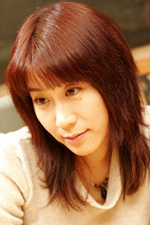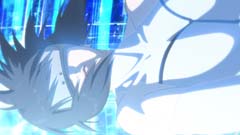Behind the Scenes Part 7: Yoko Kanno (Music Composer) III
The music for Ghost in the Shell: Stand Alone Complex is like jewelry sprinkled all over, glittering in an assortment of colors. In this third and final part of our interview with Yoko Kanno, the composer tells us about the importance of coincidences and first impressions in the compositive process.
Part 7: Yoko Kanno (Music Composer) III
"I am attracted to something that barely exists at the balance between things."
 | Profile Born on March 18, in Miyagi Prefecture, Yoko Kanno is a music composer, arranger and pianist. She has written and performed music for many commercial films, TV dramas, feature films, animation and video games, and is currently one of the most world-renowned of Japanese musicians. She wrote the score for famous animated works, including Macross Plus, Cowboy Bebop, Vision of Escaflowne and Wolf's Rain, and is the most trusted composer by veteran and new-wave directors such as Yoshiyuki Tomino, Shinichiro Watanabe and Shoji Kawamori. |
Did you use Sound Director Kazuhiro Wakabayashi's music menu as a guide for your work again this time?
Of course. I have composed about 35 or 36 scores in total for Solid State Society. And I received menus for 70% of them.
Which of Wakabayashi-san's music menus was most impressive?
I must say the menu for the scene with Togusa and his daughter. It was most solemnly written. I think the director had a special sentiment for it too. I felt this was an important scene, so I wanted to dedicate more time to it and for this reason I left it until the end. But when I actually set out to work on it, I just couldn't get on with it. So I pulled out all the scores I composed for Solid State Society and listened to them. It was strange. The first piece I composed, which I thought I would never use at the time, fit perfectly. This was a total coincidence. If I meant to do such a thing, it would never have happened.
When a person renders a scene, generally, the outcome depends on the person's preference. Some people tend to lean toward negative views and others, positive. I prefer something that is a mixture of various perspectives or opinions and feelings. I am attracted to something that barely exists at the balance between things. If you push on with monotone or only use a certain pattern, perspective or point of view, people will get bored. The brain is not the only active factor in music creation. I sometimes wait for a coincidence to take place, use my body to create, or borrow someone else's brain, and at times, my emotion goes out of control. I would always like to blend in these cluttered qualities into my work.

Do you compose music using your head or is it more to do with your senses?
Actually, I don't really know the details of the storyline even now. I read the script once quickly. I just ignored the details, and there are parts that I don't even remember. But it's the best way for me to create music. It doesn't work for me if I get absorbed in thought. From my experience, it's best to give priority to my first impressions.
Let's talk about the opening song, player. I heard you had a chance to talk with Tetsuya Nishio, who was the animator for the opening sequence.
This is another strange story. We were chatting about dream interpretations. Kamiyama-san was with us too and I asked him, "Tell us about your latest dream." He replied, "Something to do with red." Then I looked at him - he was wearing "red" glasses and had "red" sneaker strings. He had an unforgettable dream about the color red and was trying to investigate what it meant to wear red.
But I've heard that you told Nishio-san, "White is the theme color."
It might be a rebound to 2nd Gig, which had a blackish color tone - I am not sure. I don't remember telling him that. Maybe because Nishio-san's head went blank at the time. (lol)
What about the climax scene of Kusanagi and Batou?
Yeah, right. What was that? You know the scene where Batou puts his arm around Kusanagi's hips. What was the intention? I'd like the director's clear answer! (lol) Anyway, this movie had a very nice ending. It felt different from the previous TV series. This time, I could feel their passion, like, "We will be back!" Until now, the series ended with Kusanagi saying, "The network is vast" and that felt like a statement without an answer. But this time around, I felt an energy surging forward. I thought this feeling was very important. And that led to date of rebirth, which was used for the credit sequence at the end.
I understand from your words that your music is made with your love for the project and the staff. It seems like your eagerness to enrich the content comes through in your music.
The ultimate root of my music making was a love letter. When I was in kindergarten, I really liked one boy and I composed a song called, "I like you very much" for him. This was the first song I composed. I guess I couldn't say it with words. But I could with music. So it is true that even with Solid State Society, I compose a score to tell the director, "I love this scene!"
Director Kamiyama said he was grateful because, according to his words, "Kanno-san composed score after score as if a big sister was helping me out."
Ha-ha. (lol) Next time, I might try to compose from Motoko's stance. You know, she is quite sadistic and cruel, don't you agree? She is more likely to say, "You are totally dumb." (lol)
(3 - end)
Originally published in Japanese on clappa!
http://clappa.jp
© 2002-2006 Shirow Masamune - Production I.G/KODANSHA

![WORK LIST[DETAILS]](/contents/works/design/images/left_title.gif)



 terms of use
terms of use